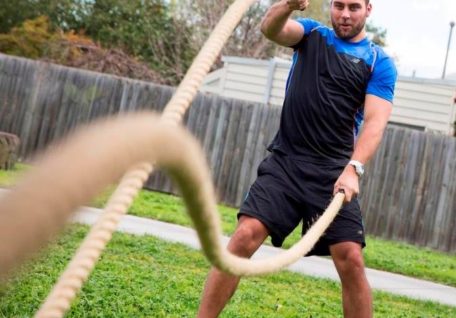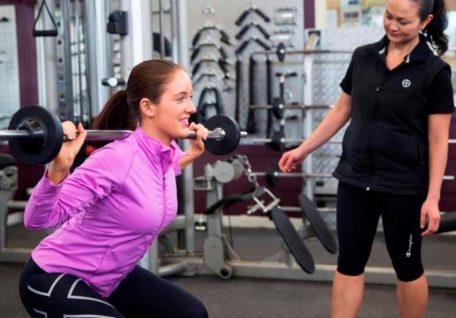
The Speedo LZR swimsuit was launched in February 2008. Made of woven polyurethane and spandex, the suit allowed for better oxygen flow to the muscles and held the body in a more hydrodynamic position. With 92% of all swimming medals at the 2008 Beijing won by athletes wearing it, body-length swimsuits were subsequently banned in 2010.
On the other hand, Cathy Freeman’s head-to-toe Swift body suit in which she won the 400 metres gold medal at the 2000 Sydney Olympics attracted no controversy – even though it was designed to reduce wind drag and manage muscle temperature!
Clothing that boosts performance
In spite of some controversies, the performance enhancing benefits of fitness specific apparel have come to be widely accepted by consumers. Compression garments, for example, are now very popular.
Compression garments
Compression garments, like those produced by partner brand 2XU, have a very elastic quality due to the high Lycra content. The material clings tightly to the skin, squeezing the muscles without causing discomfort. While there is a lack of quality evidence to show that wearing compression garments improves performance, there is general consensus that they enhance recovery by reducing oedema (swelling) in muscles and joints, preventing delayed onset muscle soreness and aiding the recovery of soft tissue injuries, thereby influencing future performance.
Other examples of acceptable performance enhancing garments include:
- Jumpsoles: weights worn on soles of shoes to strengthen leg muscles
- Nike Zoom Victory Spike: at 93 grams, a very lightweight spike
- Nike Pre Cool Vest: lowers core temperature to improve muscle performance
Benefits of fitness specific apparel
Choosing the right athletic apparel is a critical decision for today’s weekend warrior as much as the elite professional athlete. As one self-confessed middle aged man in Lycra (MAMIL) urges his critics to consider:
“The alternative to exercising in Lycra is a sore bum and chafed thighs, so give middle-aged blokes a break.”
There are sound reasons for thinking carefully about what you wear in competition or daily workouts.
Comfort
A comfortable athlete is more likely to perform well.
- A snug fitting swimsuit is better than swimming trunks that drag in the water.
- Sports bras will help to reduce the physical discomfort caused by breast movement during exercise.
- Chamois pads in cycling shorts will protect your nether region from saddle pain.
- ‘Dri-fit’ clothing (made of microfiber and polyester fabric) will move perspiration away from the body to the outer surface of the fabric where it evaporates, keeping you dry and comfortable.
Safety and protection
A safe athlete wears athletic apparel to avoid accident or illness that might otherwise interfere with their workout routine or race plans. Hypothermia and hyperthermia are serious conditions and can take you by surprise. Sportswear should keep you warm in cold situations, and allow you to stay cool in hot situations.
- A good helmet will provide you with a balance of coverage, ventilation and comfort.
- Reflectors in sports attire will make you visible in low light conditions.
- Gloves in the gym will prevent callouses on your palms.
- Long sleeves and a hat will protect you from sun exposure.
- A top made of breathable material will allow excess heat to be removed from your body in hot weather.
- Gloves, warm socks and a hat in cold weather will protect your extremities and decrease the large percentage of body heat that is normally lost from the head.
Injury prevention
The cautious athlete will take steps to wear properly fitted apparel specific for purpose.
- Correctly fitted shoes will prevent blisters and cramps.
- Orthotic inserts will support running and jumping movements.
Post performance recovery
An ambitious athlete will aim to quickly restore muscle form and body temperature after exercise.
- Compression garments are best kept on after a training session.
- Post-exercise cooling jackets will remove accumulated body heat.
Wearable Sports Technology
Athletes can now collect a range of fitness-related metrics in wearable heart rate monitors and fitness trackers – such as distance covered, calorie consumption, heart rate and quality of sleep.
Sensors and devices that fit into sports garments are moving beyond science fiction and now becoming a reality. Wearable devices help to maximise performance and decrease risk of injury by providing information on when an athlete is fatigued, dehydrated, or over-exerting. For example, Catapult is worn between the shoulder blades and uses GPS and Inertial Movement Analysis to track the body’s movements. American football teams have noticed an 88% reduction in soft tissue injuries among their football players with Catapult.
The innovations taking place with wearable sports technology will significantly impact the feedback we receive on our exercise and impact the way we engage sport into our lifestyles. In the future, sport apparel will generate a sophisticated range of measurements that will provide the consumer with ‘actionable insights’ to enhance sports performance and, when appropriate, guide sports therapy. For example, textile embedded sensors in compression shirts and socks are being developed by Heddoko to track the movement of the body joints; the aim is to teach athletes how to improve their techniques and avoid injury through instantaneous data capture with concurrent modelling on their smart devices supplemented by live coaching feedback.
Translating confidence into performance
The term, ‘enclothed cognition’, was introduced by cognitive psychologists, Hajo Adam and Adam Galinsky, in 2012 to acknowledge the theory that wearing clothes means assuming a particular identity and experiencing mental changes, which elicit corresponding behaviours from the wearer. Hence, Adam comments, “when you wear athletic clothing, you become more active and more likely to go to the gym and work out”.
In discussing the impacts of the 2008 Speedo LZR swimsuit and Cathy Freeman’s suit, sports psychologist, Jeff Bond, notes that clothing can imbue confidence in the athlete and “whether there is a placebo effect or not, if you believe it will work, it will work.” Furthermore, he states,
“Freeman ruffled her competitors by appearing on the starting line in her suit.”
While debate may occur over the value or otherwise of fitness specific apparel, there appear to be benefits for athletes who wear it. The future of wearable technologies makes the space of fitness specific apparel look even more exciting.
Uniform for success
We recognise that wearing sports specific clothing is great for all the reasons mentioned above, and is why we partnered with 2XU to provide all of our students with the best quality uniforms to wear for their work experience. If you’re interested in a career in fitness, take a look at our fitness courses and enquire today.
Author: Kara Gilbert – Kara is an active sportsperson across triathlon, athletics and recreational cycling and is currently President of Glenhuntly Athletics Club. Kate is also a medical and health expert who regularly commentates on a range of sport health matters for recreational and professional athletes.






